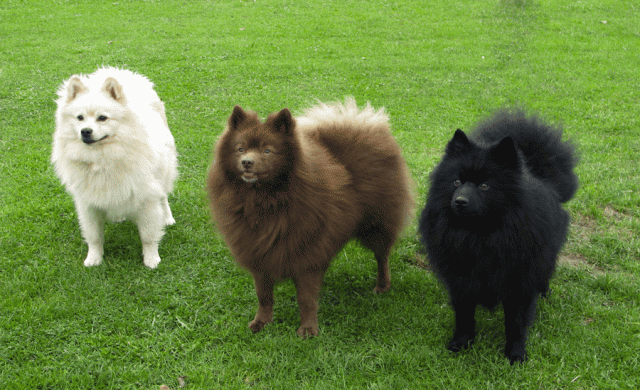Type the name of the breed you're looking for below
[wpdreams_ajaxsearchlite] Don't see the breed your're looking for? Click here and let us know!
Breed Characteristics
1 paw - breed exhibits the least amount of this characteristic
5 paws - breed exhibits most amount of this characteristic
German Spitz: Standard
| Other Names | Medium/Standard Spitz, German Spitz Mittelspitz, German Spitz, Standard Deutscher Spitz |
| Country of Origin | Germany |
| Weight | 23 - 41 lbs. (10.5 - 11.5 kg) |
| Height (at withers) | 11.5 - 14 in. (29 - 36 cm) |
| Coat | The hair on the head is short compared the rest of the body, but it is still very thick. |
| Colour | The Standard German Spitz comes in a wider variety of coat colours than some of its Spitz cousins, including black, brown, orange, wolf gray and white |
| Litter Size | 1 - 3 puppies, average 2 |
| Life Span | 12 - 15 years |
| Origin & History | The German Spitz is directly descended from the profusely coated Nordic herding dogs, such as the Samoyed and the Lapphund. It was said to have arrived in Europe with Viking plunderers. German literature refers to the Spitz as early as 1450. The Giant and Toy German Spitz have always been used as companion dogs, while the more common Standard Spitz was once used as a resourceful farm worker. The Toy German Spitz was imported to England from Pomerania, Germany, over 100 years ago and adopted the pseudonym Pomeranian. It was a favorite of Queen Victoria and was occasionally called the Victorian Pom. The Pomeranian has since developed separately with its own standard. German Toy Spitzes and Pomeranians are very similar, but they are separate breeds. The German Spitz is rare and has been losing popularity even in its homeland. |
| Personality | Happy, alert, watchful and buoyant, German Spitzes make good watchdogs. They are excellent jumpers and love to stand on their hind legs. They enjoy a lot of human attention, and are very happy to please. Teach this dog early that it may bark a couple of times when the doorbell rings or when there are visitors, but then to keep quiet. Be very consistent about this. They are alert, curious and very busy. They must be taught that the owner is the boss, or they will not listen. This breed may become too demanding if the owner allows it. If you do not show this dog all humans are pack leader to him, he will not be trustworthy with children. They may become nervous and snappish toward them. However, they can get along well with children so long as the child is taught how to demonstrate leadership skills. It is a good companion for an elderly person. Without a stern, confident, consistent pack leader, they will be feisty, willful, bold, temperamental, and will not be easy to obedience train. When trained properly they make good companions. Along with being a strong pack leader, socialize well to avoid them from becoming reserved and barking at strangers, other dogs and animals, which may lead to dog aggressiveness. They are very beautiful and elegant in the show ring. The best way to reinforce your pack leader status is to take them for daily pack walks. This not only helps the dog see you as the leader, but it releases mental and physical energy, making the dog stable minded, level headed and confident that he knows his place in the world. |
Care Requirements
| Health | Patellar luxation |
| Grooming | Regular brushing is needed to prevent matting. Some Spitzes do not like to be groomed and you have to teach them to stay for you during the grooming session. |
| Exercise | This breed needs to be taken on a daily walk or jog. They will happily company their owners on a 20-mile walk or one mile daily walk. |
| Other Considerations | The German Spitz is good for apartment life. It is fairly active indoors and a small yard will suit it. |



